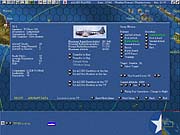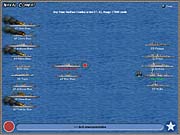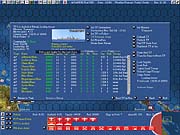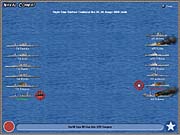With a learning curve as steep as Mt. Fuji, an interface that only an accountant could truly embrace, an avalanche of information to be assimilated, graphics that are merely serviceable, and sound that seems spartan at best, it would be all too easy to categorize Uncommon Valor: Campaign for the South Pacific as a game suited for only the most die-hard grognards. But this type of pigeonholing is erroneous, because the latest from wargame icon Gary Grigsby has untold rewards to offer gamers--even strategic greenhorns--if they're willing to invest the time and effort needed to master the game's complex yet highly efficient interface. There's no denying that Uncommon Valor falls squarely into a category many have dubbed "spreadsheet wargames," and it certainly has quirks and even a few bugs that can initially seem annoying. But take our word for it: A little patience and a lot of practice is likely to produce some highly addictive results, even for those who felt overwhelmed and frustrated by Grigsby's earlier efforts such as Pacific War and War in Russia.

Uncommon Valor doesn't attempt to cover the entire scope of operations in the Pacific Theater during WWII. Instead, it focuses on the campaigns and battles that essentially determined the final outcome of the entire Pacific War, and all action takes place on a single map ranging from Truk in the north to Brisbane in the south, including the invaluable Solomon Islands chain and bases at New Caledonia.
While some wargamers may yearn to get their hands dirty in Burma and Indochina, let's get realistic--by the time American war production had fully ramped up by 1943, the outcome of the conflict was never seriously in doubt regardless of those operations (not to slight the bravery and brilliance of the men and tactics employed in those regions, of course!). The only real question was how long it would take to reach the finale and how many men would sacrifice their lives in the process. Yamamoto understood the production capabilities of the United States and actively sought a decisive battle (Midway) that would bring America to the bargaining table.
But strangely enough, the setup for Decision in the Pacific, the game's grandest campaign, does not incorporate the results of that battle: It's a hypothetical scenario that assumes that the Japanese did not suffer the devastating losses in carriers and pilots that forever changed the course of the war. In total, Uncommon Valor features 17 scenarios, which range in length from a "mere" 10-day operation to a massive 20-month campaign where the Japanese operate at full strength without the fatal blows incurred at Midway.

But before we get into the game's mechanics and design, one issue must be addressed: the lack of a printed manual. Matrix Games claims that the cost of printing manuals for a game aimed at a niche market would have made the retail price skyrocket, while detractors argue that not only is a print manual incredibly valuable as a desktop reference for a wargame of this depth, but the costs to print out the online manual could run as much as $30 or $40--the cost of a new cartridge or paying to have it done at a local print shop.
Then again, Matrix Games isn't cranking out hundreds of thousands of copies of the game, and therefore its printing costs would be considerably higher than for the average retail product. We ended up printing out only those sections where we needed clarification. The bottom line is this: Either get used to the Alt+Tab routine for checking documentation online (Uncommon Valor is quite friendly when it comes to multitasking), use some common sense when printing out the docs, or pay a printer to do the whole thing. If it costs you $30 for the print job, the total cost for the game is $80, and that's not bad, given that you can probably count on hundreds if not thousands of hours of gameplay from this one, thanks to play-by-email (PBEM) support.
This is a turn-based game where turns can last between one and seven days of game time, or turns can be set for continuous play until paused. It uses a hex system (30 miles), and the attrition rate is individual units--you'll see reports of damage and effectiveness for every bomber, fighter, and ship in the game. This level of detail necessitates a lot of micromanagement: While some tasks such as resupply can be automated, only the laziest commander would set things on autopilot and hope for the best. What this means in real-world terms is that you need to oversee all aspects of any operation. Loading supplies and troops, assigning bombing targets and escort missions, coordinating supply convoys, sending out mine-laying missions, and so forth. The "spreadsheet" design for doing all this is admittedly cumbersome at first, but after one or two phases (which can last from one to seven days) it all becomes a routine--but one in which you must react to the changing positions of enemy deployments and maneuvers, as well as your limited resources including aircraft range and readiness.

Is it time-consuming? Yes. Is it rewarding? Doubly so. Once you fully comprehend the somewhat complicated interface, you can begin reinforcing and supplying crucial bases with undreamed-of ease. Ground battles are rare in the early portions of the campaign, and even when they become more common, at this point, they disappointingly lack much zest or verve.
To put it simply, Uncommon Valor requires patience, and those who have enough of it will find so much depth in the game that all their efforts will be rewarded many times over, even without the glossy graphics of simpler (but still enjoyable) games such as Pacific General. Those who shun micromanagement might shudder at what they face in Uncommon Valor, but it's really not that bad. After a while, ensuring that troops are being transported where they're needed, checking on fuel and supplies at each base under your control, and giving battle-weary air groups much-needed rest to ensure future effectiveness can even become an obsession.
But in a game with such a sweeping scope, there are bound to be errors and annoyances, and Uncommon Valor has more than a few--some minor, some not. As an example, fatigue for transport units is heavily weighted for some reason, with the convoy losing 1 percent of its cargo even on clear, open roads. And in terms of AI, there are many incongruities, especially for friendlies. Catalinas ordered to carry out antisubmarine patrols, for instance, do a pretty good job of reporting sightings, but not once did we see any of them actually attack a Japanese sub. That's pretty strange, considering how many depth charges those babies carried. Antisub warfare seems to be the game's weak point--it's possible to send out countless PBYs and other aircraft to spot subs and never get a nibble.
There are some other oddities that even a newcomer will notice. For instance, you must set a target destination for a convoy before loading it with troops or supplies. This strange obsession with order of maneuvers is baffling, but Matrix says it's "logical." This feature is listed in the manual, but that doesn't change its counterintuitive nature.

You'll also encounter other strange features, such as overmanned air squadrons, infantry icons disappearing from bases after troop transports are selected, coastwatcher and plane sightings that don't tell you the direction in which a task force is headed--which is crucial for strategic planning--a lack of mousewheel support in a game where scrolling through lists is essential, no feedback as to whether a certain order can be carried out, and task force commanders completely disobeying the "don't react" order and charging to certain death (or fleeing from paltry dangers).
Guess what? None of it really matters. There is simply so much to do and so much to enjoy that you will overlook these quirks and slowly but surely set your sights on crushing the imperialist intentions of Japan (or, since you can play as the Japanese, end the capitalist, imperialist onslaught of the ABCD coalition--America, Britain, China, and Denmark). Uncommon Valor takes much time to fathom, but after that time is over, you'll end up enjoying it greatly.